Checkin at London Heathrow for your overnight flight to Colombo.
Transfer to Weligama, drive time is approximately 2 hours.
These days at the beach will be at leisure.



Galle Fort Walking Tour
Before the Dutch took Colombo from the Portuguese, Galle was their headquarters. Contrary to the Colombo Fort, the one in Galle was not only not demolished, but is one of the best preserved examples of 17th century colonial fortifications in the world, and is on the UNESCO list of World Monuments. The reason for its remarkable state of preservation is that this once busy trading town, visited by the East-India fleets and many regional traders, fell upon slack times after the Dutch had left. The development that did take place focused on the new town of Galle, outside the Fort.
The Fort is really a walled city, with a rectangular pattern of streets full of the low houses with gables and verandas in the Dutch colonial style. An irony of history is that most of the inhabitants of old Galle, occupying the houses of the Dutch, are the descendants of the Muslim traders that the Dutch despised so much for their petty trade that violated their monopoly. The Muslims have adapted many of the houses to their own likings, closing up the verandas with woodwork to prevent their women from being seen from outside. Recently it is no longer allowed to alter any of these houses, some renovation is taking place, and private museums with handicraft shops have even been established.
There are also several interesting buildings from early British times, and an early 20th century light tower. The fort was started by the Portuguese in 1588, but there is nothing recognizably Portuguese left. Probably parts of the thick walls, that you can walk on almost all around the town, in the sunshine and the cool breeze, with the red-tiled roofs of the houses on the one hand, and the blue ocean on the other.
Jeep Safari at Yala National Park
Located in the wild south-east part of the island, this region is a haven for flora and fauna and excellent game. The beaches are backed by large sand dunes giving rise to lagoons, woodland and scrub bush. The premier wildlife location in Sri Lanka, Yala offers an almost African safari experience as well as an important Buddhist temple site. On game drives by jeep, one can usually view wild elephant, buffalo and boar, huge monitor lizards, macaque monkeys and many rare and endemic bird species: it is also the best place in south Asia to spot the elusive leopard, often seen and admired. Lazing on a treetop, blending in perfectly with its surroundings, the big cat is almost invisible, yet the absence of tigers in Sri Lanka makes for a leopard with real attitude. Usually tagged ‘Prince of the Night’, this cat is well out of its normally nocturnal closet. Confident, it will stroll in the open by day, to every ecotourist’s delight. There are believed to be about 600 leopards across Sri Lanka today, mostly in the protected parks and reserves. Yala National Park has one of the highest recorded densities of leopards in the world, The Sri Lanka Sloth Bear-shaggy, shuffling and rather hunch-backed black bears may be seen loping around even in daylight and are endemic to Sri Lanka. This park is famous for its high density of leopards, perhaps the highest in the world. You are also sure to see elephants – grumpy loan males during the dry months and large herds in the wet season. Sloth bears are also a big draw. You will also see mammal such as wild boars, several species of deer and wild buffalo. There is a plethora of reptilian species and platoons of crocodiles. As is common in Sri Lanka there is a huge diversity of stunning birdlife including migratory species such as the flamingo. It is also one of the few places in the world where the severely endangered black necked stork can still be seen. The uniqueness of the park is the sheer diversity of the habitat: dense jungles suddenly gives way to lagoons and open plain areas and the park has a simply beautiful sea front. Huge, stark boulders dominate the horizon and the elegant, languorous leopard can often be seen basking atop the sun baked rock.



Morning
Afternoon
Jeep Safari at Yala National Park
Morning Jeep Safari Yala.
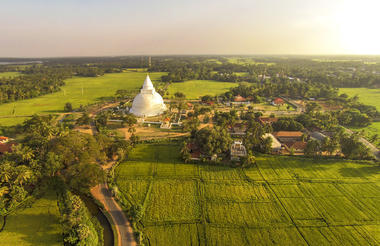

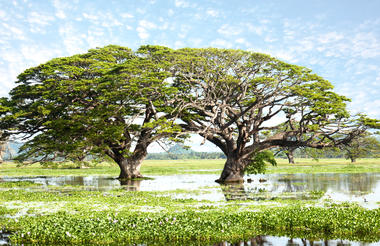
Morning
Transfer to Ella - drive time is approximately 4 hours



Little Adam’s Peak
Ella is a hiking hotspot in the mountain country of Sri Lanka. Some of the views from hikes in Ella are phenomenal with the region well known for its tea plantations and spectacular mountain ranges. If you want to enjoy some of the best views without needing to hike for hours, Little Adam’s Peak is the perfect trek, especially for an unforgettable sunset.
Little Adam’s Peak Trail begins with a moderate incline as it winds through tea plantations. There are some great photo opportunities early on in the hike if you keep your eyes open!
The beginning of the path goes through beautiful, lush green tea plantations full of tea picking ladies. 1141 m high, is fairly easy to climb, with a good path all the way up.
9 Arch Bridge
The glorious Nine Arch Bridge between Ella and Demodara station is one of the engineering marvels in the early 20th century. This bridge, which is almost 100 years old, has been built with blocks of stone and cement without any strengthening iron or concrete. The giant arches take the bridge on a curved path to link to mountains. The Bridge was commissioned in 1921 under the British Government.
Access to the place is not that hard, but takes some rail walk from Ella town. There is a story behind it that you would love to hear.
The World War One broke out and the steel consignment allocated for this site was seized and was used for war related projects. When the work came to a stoppage the Sri Lankan (named Appuhami) came forward and build the bridge with solid stone bricks and cement without steel.
Ravana Falls
Ravana Falls is another must visit in Ella. Hill country of Sri Lanka is quite popular for beautiful waterfalls and Ravana Falls is right at the top.
The falls are quite impressive, and you can climb over some of the rocks to get a closer look. If you love water and want to have some splash time, enjoying some hours in the water fall, then this is the place in Ella. You can spend some time swimming, but be safe as the rocks are slippery.
It currently ranks as one of the widest falls in the country. This waterfall measures approximately 25 m (82 ft) in high and cascade from an oval-shaped concave rock outcrop. During the local wet season, the waterfall turns into what is said to resemble an area flower with withering petals. But this is not the case in the dry season, where the flow of water reduces dramatically.
Ella Zip-line
Flying Ravana is Sri Lanka’s first ever zip-line, located amidst the luscious green estates of Ella. The two-wire zip-line stretches for more than half a kilometre, slides at 80kmph and offers a bird’s-eye view of the beautiful hills of the island. It is exclusively designed for adventure enthusiasts and adrenaline junkies who prefer a not so ordinary hillside experience.



Morning
Little Adam’s Peak
Afternoon
9 Arch Bridge
Afternoon
Ravana Falls
Afternoon
Ella Zip-line
Drive time to Pasikudah is approximately 4 hours
The beach stay would be at leisure (no arrangements made)

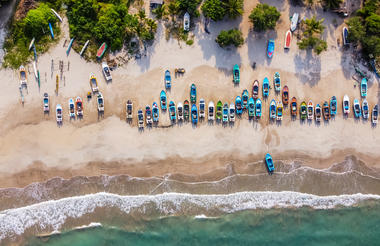

Ancient City of Polonnaruwa
Polonnaruwa was the 2nd capital city of Sri Lanka, built in the 11th and 12th centuries AD, and which is also a World Heritage Site. Within the ruins of the Royal Palace, the Gal Viharaya, there are four splendid statues of the Buddha in 'Upright', 'Sedentary' and 'Recumbent' postures carved out of rock. In addition, the remains of stunning buildings including the Audience Hall, the Lotus Bath, king Parakramabahu's statue, and the Parakrama Samudraya lake built by King Parakramabahu the great, provide an insight into this great historic city. Polonnaruwa is also home to monuments of famous places of worship including the Shiva Temple, the Lankathilake, the Watadage, the Galpotha, the Kiri Vehera and the remains of a former Temple of the Tooth Relic, now found in Kandy. Approximately a one-hour drive from Sigiriya, we recommend most clients visit Polonnaruwa in conjunction with Sigiriya during a stay in the Cultural Triangle. Visiting Polonnaruwa in the morning combines well with an afternoon Jeep Safari from Harbarana, in one the close-by national parks to see wild elephant and the vast array of local wildlife.
Jeep Safari – Minneriya National Park
The Minneriya Tank was created by King Parakarambahu at the height of Polonnaruwa’s glory as the capital of Sri Lanka. The national park based largely around the huge tank (reservoir) was created rather more recently but serves as an important gathering place for Sri Lanka’s large population of elephants. It is a great place for elephant spotting all year round – though as the dry season makes water scarce between June and September, more and more elephants gather on the shores of Minneriya Tank.
Indeed by late August and September, the awe inspiring site of up to 300 elephants can often be seen, in a phenomenon known as ‘The Gathering’. It is the largest concentration and gathering of Asian elephants that can be seen anywhere in the world. Watching baby elephants playing with each other, bull elephants tussling for dominance and the great matriarchs surveying the scene is not a sight you are likely to forget in a hurry. Aside from the elephant, Minneriya is also home to some 23 other species of mammals: some, like the Deer and Sambur you will see, some like the Leopard and the Sloth Bear will probably prove elusive. The arid dry zone is a paradise for many species of Lizard and you will see them here in all their technical colour brilliance if you look carefully enough, as well as snakes like the Indian Python and the Mugger Crocodile. Above all, of course, are Sri Lanka’s wonderfully varied bird population. Among the 150 or so species, particular favorites of ours you may see in Minneriya include the beautiful painted stork, and various other bird species.



Morning
Afternoon
Jeep Safari – Minneriya National Park
Jeep Safari at Wilpattu National Park
The park is situated along the Northwest coast lowland dry zone of Sri Lanka. It comprises of a unique complex of lakes called Villus, which are natural basins that are filled up with rainwater and are surrounded by open grassy plains set within dense scrub jungle. A multitude of sandy paths wind around the entire park and open up into these large natural lakes. The unspoilt and beautiful Wilpattu National Park is one of the largest and oldest National Parks in Sri Lanka. It is ideal for those wanting to escape the flurry of activity of Yala and instead offers the opportunity for a tranquil, peaceful and undisturbed drive.
The biggest draws in Wilpattu are Leopards and Sloth bears. Alongside these, it is possible to see Asian Elephants, Spotted Deer, Barking Deer, Wild Pig, Asiatic Buffalo and Mugger Crocodiles. Endemic birds include the Ceylon Junglefowl, Brown-capped Babbler, Ceylon Woodshrike and Black-capped Bulbul in riverine habitats. Muntjac or Barking Deer are more easily seen in Wilpattu than any other national park. Butterflies recorded include the Great Egg fly, Great Orange Tip, Glad-eye Bush brown, Blue Mormon, Common Mormon, Common Rose and Crimson Rose.
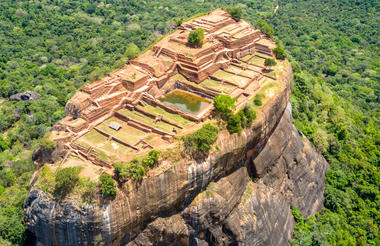
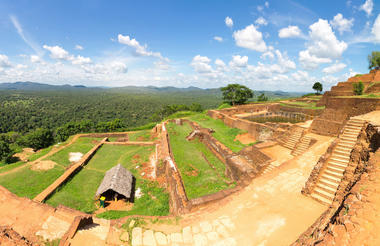
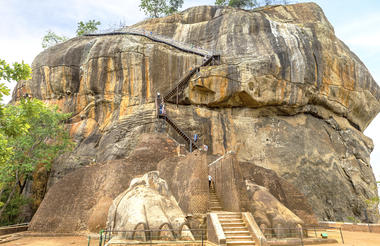
Jeep Safari at Wilpattu National Park
Climb Sigiriya Rock Fortress
This is one of the most amazing historical sites of Sri Lanka and a must visit. However, take heed, the climb to the top (about 1200 steps)takes about 1-1/2 hours. Not suitable for those who are unfit or cannot deal with heights. Take a moment to read our expert tips.
Sigiriya (Lion Rock) Referred by locals as the Eighth Wonder of the World this ancient palace and fortress complex has significant archaeological importance and attracts thousands of tourists every year. It is probably the most visited tourist destination of Sri Lanka. Sigiriya rock plateau, formed from magma of an extinct volcano, is 200 meters higher than the surrounding jungles. Its view astonishes the visitors with the unique harmony between the nature and human imagination. The fortress complex includes remnants of a ruined palace, surrounded by an extensive network of fortifications, vast gardens, ponds, canals, alleys and fountains. In the 3th century BC the rocky plateau of Sigiriya served as a monastery. In the second half of the 5th century King Kasyapa decided to construct a royal residence here. After his death Sigiriya again became a Buddhist monastery until the 14th century, when it was abandoned. The main entrance is located in the northern side of the rock. It was designed in the form of a huge stone lion, whose feet have survived up to today but the upper parts of the body were destroyed. The western wall of Sigiriya was almost entirely covered by frescoes, created during the reign of Kasyapa. Eighteen frescoes have survived to this day. The frescoes are depicting nude females and are considered to be either the portraits of Kasyapa’s wives and concubines or priestess performing religious rituals. One of the most striking features of Sigiriya is its Mirror wall.
For those who are not comfortable with heights or have problems climbing we suggest the gardens of Sigiriya which are among st the oldest landscaped gardens in the world. They are located in the western part of the rock with bridges, fountains, as well as surface and underground water pumps.



Morning
Transfer to Kegalle - Drive time is approximately 2 hours.
En route Visit the Dambulla Rock Cave Temple
Dambulla Rock Temple
The Dambulla Rock Temple was donated by king Walagambahu in the 1st century BC to Buddhist monks. Dambulla is a World Heritage Site and is the most impressive of Sri Lanka's cave temples. The complex of five caves with over 2000 sq. meters of painted walls and the ceiling is the largest area of cave paintings found in the world. These caves contain over 1500 images of the Buddha of which the largest is the colossal figure of the Buddha carved out of rock spanning 14 meters. Close to the town of Dambulla this attraction is easily accessed although it requires walking up a considerable number of steps to reach the caves from the road. If you are a little short of time, a visit to the Dambulla rock temple can be combined with travelling to or from the Sigiriya area.



Morning
Take the Train from Rambukkana to Kandy to visit the Kandy Temple of the Tooth
Train journey approx. 1 hour- 2-3 hours at Kandy Tooth Temple
The train journey is on the bucket list of most travellers to Sri Lanka. Why is the Kandy to Ella train journey so amazing? The views on both sides of the rail are breath-taking but it is a journey on one of the most charmingly decrepit railway systems in the world which reinforces the desire to travel in a modicum of discomfort!
If you are not traveling to the High tea country, this short journey gives you an opportunity to experience the trains. At Rambukkana, the line begins a steep climb into the hills. From Rambukkana to Kandy, at Kadugannawa the track runs along the edge of sheer cliffs, allowing passengers a view of Batalegala (Bible Rock). Your guide will drop you at the station and wait until you have boarded the before driving to meet you in Kandy. The train for this portion may be quicker than the drive.
Peradeniya Royal Botanical Gardens
This botanical garden was first built as a pleasure garden by a Sinhala king and was expanded by the British during the period of colonial rule. Royal Botanical Garden, Peradeniya (5.5 km west of Kandy) is renowned for its collection of a variety of orchids and includes more than 4000 species of plants, including of orchids, spices, medicinal plants and palm trees.The Botanic Gardens crested in 1371 when King Wickramabahu III kept court at Peradeniya near Mahaweli river. This was followed by King Kirti Sri and King Rajadhi Rajasinghe. A temple was built on this location by King Wimala Dharma, but it was destroyed by the British when they were given control over the Kingdom of Kandy. Alexandar Moon then created the botanical gardens in 1821. The Botanical Garden at Peradeniya was formally established in 1843 with plants brought from Kew Garden, Slave Island, Colombo, and the Kalutara Garden in Kalutara.
The classical Avenue of Palms is located in this Garden. One tree with a significant history is the Cannonball Tree planted by King George V of the United Kingdom and Queen Mary in 1901. During the Second World War, the Botanical Garden was used by Lord Louis Mountbatten, the supreme commander of the allied forces in the South Asia, as the headquarters of the South East Asia Command.



You will have a chance to get in shallow water with the elephants. We recommend you take with you a small towel and have some water shoes to protect your feet whilst in the river.
Cooking Lesson
After a relaxed breakfast, at approximately 10:30 visit the organic kitchen garden with the Chef who, along with the gardener will explain the produce and some of the spices that is grown at Rosyth. On your return to the kitchen, you will have the opportunity to cook authentic Sri Lankan curries. You may be joined by other guests. The maximum number of guests is eight. The menu has been designed to include ingredients which are available in Europe. Your hands-on cooking class will include a fish or chicken curry and three other vegetable curries and a traditional salad. Sit down for lunch in the dining room in the canopy of the trees with the curries that you have cooked and enjoy your lunch with the rice and poppadum's. You will have the opportunity to take away the recipes to replicate at home. The curries: The main curries are Chicken, Fish or Mushroom. Green bean, Lentil and spinach, aubergine & Gotkola sambal. When you sit for lunch, we will serve you red or white rice, popadoms and homemade chutneys. You will have the recipes to take home and we suggest you purchase the spices from a supermarket before you fly home.
Rosyth Tea Tasting
If you are a tea drinker or not, you may be curious about tea. A short walk from the estate house is the micro tea factory which produces small quantities of tea. You will be given a short introduction to how tea is made and an opportunity to taste a few of the teas. If you would like to make your own tea and will be at Rosyth long enough, you may be interested in the Rosyth Tea Experience. All proceeds will be given to the Rosyth Foundation which supports the local community and school.
Rosyth Estate House Tea
For decades the Rosyth Estate single origin tea had been processed at the local factory at the top our hill, which had been in operation since 1930. At 1,000 feet above sea level, the handpicked tea is used to produce orange pekoe in different grades and fannings, with the highest grade referred to as OP. Top quality pekoe grades consist mainly of buds and grading is based on the size of the individual leaves sorted in the finishing process. The size and the wholeness of the leaves has the greatest influence on the taste, clarity, and brewing time of the tea.
The Original 1930 Rosyth Tea Factory was not owned by the Rosyth Estate House and has been independently operated for generations. Unfortunately, following a tragic fire that took place in April 2022, the factory was destroyed leaving many in the local community without employment.
Rosyth Artisanal Tea – Their tea journey
At Rosyth, determined to move away from the traditional methods of producing tea that have remained the same since the colonial era, the owners have begun their journey to become an organic, artisanal producer of Sri Lankan tea. Removing much of the mechanisation from the processes they have started to produce hand crafted teas. The leaves are carefully manipulated by rolling or pounding on the estate by their local artisans. The micro factory was constructed in the first quarter of 2023 and they moved into production in the second quarter of 2023. The artisanal
This project is wholeheartedly community focused, as they look to improve the economic sustainability of the valley. Each and every person connected to production of the tea is now a partner with a stake in the future success. The partners will receive a guarantee of 10% of the estate tea revenues as a dividend payment on top of their wages. In the coming years, they hope the initiative will vastly increase the prosperity of our local community with the skills and investment to help it flourish. Artisanal Tea can be sold for
The process follows the classic steps of tea production but with an all together more personal and hands on approach:
Step one – Plucking: the fresh leaves are plucked by hand by our skilled tea pickers. For our highest quality hand rolled artisanal teas we delicately pick just one leaf and a young bud, carefully separating the slightly larger leaf which is hand processed separately. On arrival in the factory, the leaf is further inspected & any stalks removed.
Step two – Withering: the leaves are carefully laid out on withering trays, locally know at “Tats”. Tea leaves, even fresh tender ones are not pliable and would shatter when rolled and shaped. Drying gently on the tats, the leaf is left for up to 20 hours to gently wither, loosing up to 35% of its moisture content. As it withers, the leaf is gently turned to allow an even exposure to the air.
Step three – Hand Rolling: the withered leaves are now gently rolled by hand in wicker baskets by our artisans to gently break the cell structure of the leaf and to release the enzymes & natural oils within the leaf. Natural juices are slowly released, and the leaf becomes slightly sticky to the touch. Taking up to two hours to complete care is taken to maintain the structure of the leaf.
Step four – Oxidation: after completing the rolling, the leaf is left for up to two and half hours to allow oxidation to take place. This is the critical part of the process where the air interacts with the now exposed enzymes, heat is produced, and the flavour of the tea fully develops. The leaf turns a reddish-brown colour as the chemical composition changes & the wonderfully complex flavours of our tea develop. The time taken for oxidation varies, depending on a number of factors including the air temperature and the humidity levels, but as the chemical reactions develop and temperatures around 43c are reached, it is time to stop the oxidation and dry the tea.
Step five – Firing: time is now the essence, the tea needs to be dried, the oxidation process stopped, and leaves dried to perfection. In our artisan factory the leaf is spread onto the trays and placed into a drying over at temperatures between 85-110c. Good even drying, with low residual moisture levels, is essential to being able to store the tea, typically reached in one & a half hours.
Step six – Grading and sorting: once dried, the clock stops ticking and we can be more relaxed with final sorting and grading of the tea. Our highest quality OP grades are carefully sorted, before all the teas are packed into airtight foil bags to maintain the optimum freshness. Nothing is wasted, the small leaf particles carefully separated and blended to produce lower grade teas – in large commercial factories this would often end up in tea bags!
Guided Rosyth Estate Walk
A member of our team can guide you through the Estate and give you an appreciation of rural Sri Lankan life as you wind through paddy fields, jungle, fresh water streams and meet local villagers on the way. If he is not available, one of the hotel or estate team will accompany you on a guided at approximately 4pm. You may be joined by other guests,
Rosyth is a small working estate. Tea is plucked by hand and hand crafted into the artisanal tea factory. Latex is tapped by scoring the tree, then collected and and sold to a local rubber factory. Coconuts, fruits, spices and vegetables are grown on the estate and used at the hotel. You will be amazed by the variety of produce that grows on the estate!
If you prefer to walk on your own ask the team for some directions and enjoy forest bathing: immerse in nature .The Estate and its surroundings contain beautiful walking trails & mountain biking routes over the rolling hills. Guests are free to explore the estate and join the ladies plucking tea. Guides for two of our local walking trails, so you can independently explore the beautiful part of Sri Lanka’s Low Tea Country.



This morning you will depart after breakfast for the airport and your return flight to the UK.




